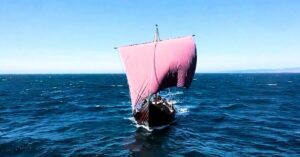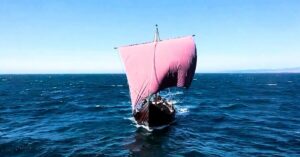10th-Century Viking Ship Replica Navigates Ancient Routes & Berths In Montenegro’s Adriatic Port Of Bar

Iran Releases Oil Cargo From St. Nikolas Tanker Seized In January 2024 In The Gulf Of Oman
July 26, 2024
Cargo Ship With 9 Crew Members Sinks Off Taiwan Coast After Typhoon Hits, Search Underway
July 26, 2024

Saga Farmann, a replica Viking ship, has docked in Montenegro’s Adriatic port of Bar as part of its extended tour around European seas, inspired by the Norse sailors who conquered, explored and traded over a millennium ago.
Saga Farmann, a full-size archaeological recreation of a 10th-century Viking cargo ship or Knarr, was built out of oak and pine.
The original ship was discovered in Norway in 1893 but wasn’t explored until the 1970s.
Linda Sten Vagnes, one of the trip’s leaders, states that the ship can travel to Greenland, Iceland or even North America.
The expedition, which began in 2023 and is scheduled to end in 2026, was initially intended to follow the Norwegian coast into the White Sea off northern Russia and along the Volga River.
However, due to the ongoing conflict in Ukraine, the route was adjusted to traverse the rivers of Europe from west to east.
The Viking age, which lasted from the 8th to the 11th century AD, saw Norsemen embark on extensive maritime expeditions from Scandinavia, using their powerful longships to raid, trade, and colonize vast regions, including North America.
Saga Farmann’s voyage was inspired by ancient sagas of Viking expeditions to Constantinople, the Byzantine Empire’s capital at the time.
Video Credits: AzPost/YouTube
To make an exact replica of a Knarr, supporters worked tirelessly for years, with help from the governments of Denmark and Norway.
The vessel was launched in 2018. Axel Hubert Persvik, a shipbuilder involved in the project, stated that it requires an extended time as a majority of the craft is done by hand.
On its most recent leg, the 21-meter (69-foot)-long and 5-meter (16-foot)-wide ship sailed from the Aegean Sea to the Adriatic.
Zander Simpson, the ship’s captain, stated that the next phase of the trip is around Italy, Sicily, with a stop in Rome during the winter before next year’s stage, which will take it along the Italian coast, the French Riviera to Paris.
Saga Farmann is equipped with sails and oars, as well as four electric motors for upwind and upstream propulsion. More than three tons of batteries are stored onboard for propulsion and ballast.
Saga Farmann Background Story
A Knarr ran aground in the shallow waters of Klåstad Bay near Larvik, Norway, around the year 1000.
The ship was loaded with whetstones and possibly sheep from Telemark County nearby.
The shipwreck was discovered in a field around 900 years later due to the land rising over time.
Professor Arne Emil Christensen led the 1970 excavation of the wreck, now displayed at the Slottsfjellsmuseet in Tønsberg, Norway.
The Oseberg Viking Heritage Foundation, renowned for making archaeological replicas of Viking ships, took on the project of reconstructing the Klåstad ship.
The Klåstad ship had never been reconstructed, unlike the well-known Oseberg and Gokstad ships, which had been copied several times since the late 1800s.
A cardboard scale model was created as the foundation for new building designs, using results and proven re-engineering methods.
A new ship was eventually constructed and named Saga Farmann.
Reference: Reuters
10th-Century Viking Ship Replica Navigates Ancient Routes & Berths In Montenegro’s Adriatic Port Of Bar appeared first on Marine Insight – The Maritime Industry Guide
Source: Maritime Shipping News


